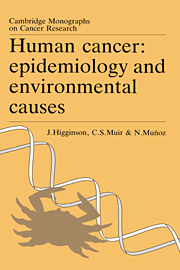Book contents
- Frontmatter
- Contents
- Contributors
- Preface
- Acknowledgements
- Historical introduction
- PART I Epidemiological methods
- 1 Introduction to cancer epidemiology
- 2 Descriptive epidemiology: the measurement of human cancer
- 3 Analytical epidemiology: techniques to determine causal relationships
- 4 Limitations of epidemiological methods in cancer studies: study of low-level risks: negative studies
- 5 Laboratory methods in epidemiology
- PART II Causative factors in human cancer
- PART III Legal and ethical considerations
- PART IV Introduction: total and specific site epidemiology
- PART V Buccal cavity
- PART VI Digestive system
- PART VII Respiratory system
- PART VIII Bone and soft tissue
- PART IX Skin
- PART X Breast and genitourinary system
- PART XI Eye and nervous system
- PART XII Thyroid and other endocrine glands, lymphoid and hematopoietic system
- PART XIII Cancers in children and multiple primary cancers
- Conclusions
- Appendix 1 Cancer statistics
- Appendix 2 A glossary of epidemiological terms
- Appendix 3 Acronyms and abbreviations
- Supplement
- Index
2 - Descriptive epidemiology: the measurement of human cancer
Published online by Cambridge University Press: 03 May 2010
- Frontmatter
- Contents
- Contributors
- Preface
- Acknowledgements
- Historical introduction
- PART I Epidemiological methods
- 1 Introduction to cancer epidemiology
- 2 Descriptive epidemiology: the measurement of human cancer
- 3 Analytical epidemiology: techniques to determine causal relationships
- 4 Limitations of epidemiological methods in cancer studies: study of low-level risks: negative studies
- 5 Laboratory methods in epidemiology
- PART II Causative factors in human cancer
- PART III Legal and ethical considerations
- PART IV Introduction: total and specific site epidemiology
- PART V Buccal cavity
- PART VI Digestive system
- PART VII Respiratory system
- PART VIII Bone and soft tissue
- PART IX Skin
- PART X Breast and genitourinary system
- PART XI Eye and nervous system
- PART XII Thyroid and other endocrine glands, lymphoid and hematopoietic system
- PART XIII Cancers in children and multiple primary cancers
- Conclusions
- Appendix 1 Cancer statistics
- Appendix 2 A glossary of epidemiological terms
- Appendix 3 Acronyms and abbreviations
- Supplement
- Index
Summary
Introduction
It is customary to assess the distribution of disease, including cancer, by age, sex, place and time. The most informative estimate of the frequency and distribution of cancer in a population comes from the cancer registry, an organization which measures incidence by recording all newly diagnosed cases of cancer occurring in a defined population. If incidence data are not available, then mortality, the number of persons in a defined population certified as dying from cancer, is used as a surrogate index of the cancer burden. The relation between incidence and mortality varies by cancer site and is influenced by the effectiveness and success of therapy and level of medical services. Many of the issues in measuring human cancer have been summarized by Muir et al. (1987) in CI5V (a commonly used abbreviation for Volume V of the monograph series Cancer Incidence in Five Continents).
The International Classification of Diseases (ICD) of the World Health Organization, now in its ninth revision, is universally used to present cancer occurrence data. The classification is largely organized on an anatomical basis since location influences cancer treatment, histological type and other factors. Indeed, the causal agent often determines the organ involved. A few cancers are primarily classified on histological or cytological criteria rather than anatomical location, e.g. choriocarcinoma, malignant melanoma of skin, malignant lymphomas and leukemia.
- Type
- Chapter
- Information
- Human CancerEpidemiology and Environmental Causes, pp. 5 - 26Publisher: Cambridge University PressPrint publication year: 1992

